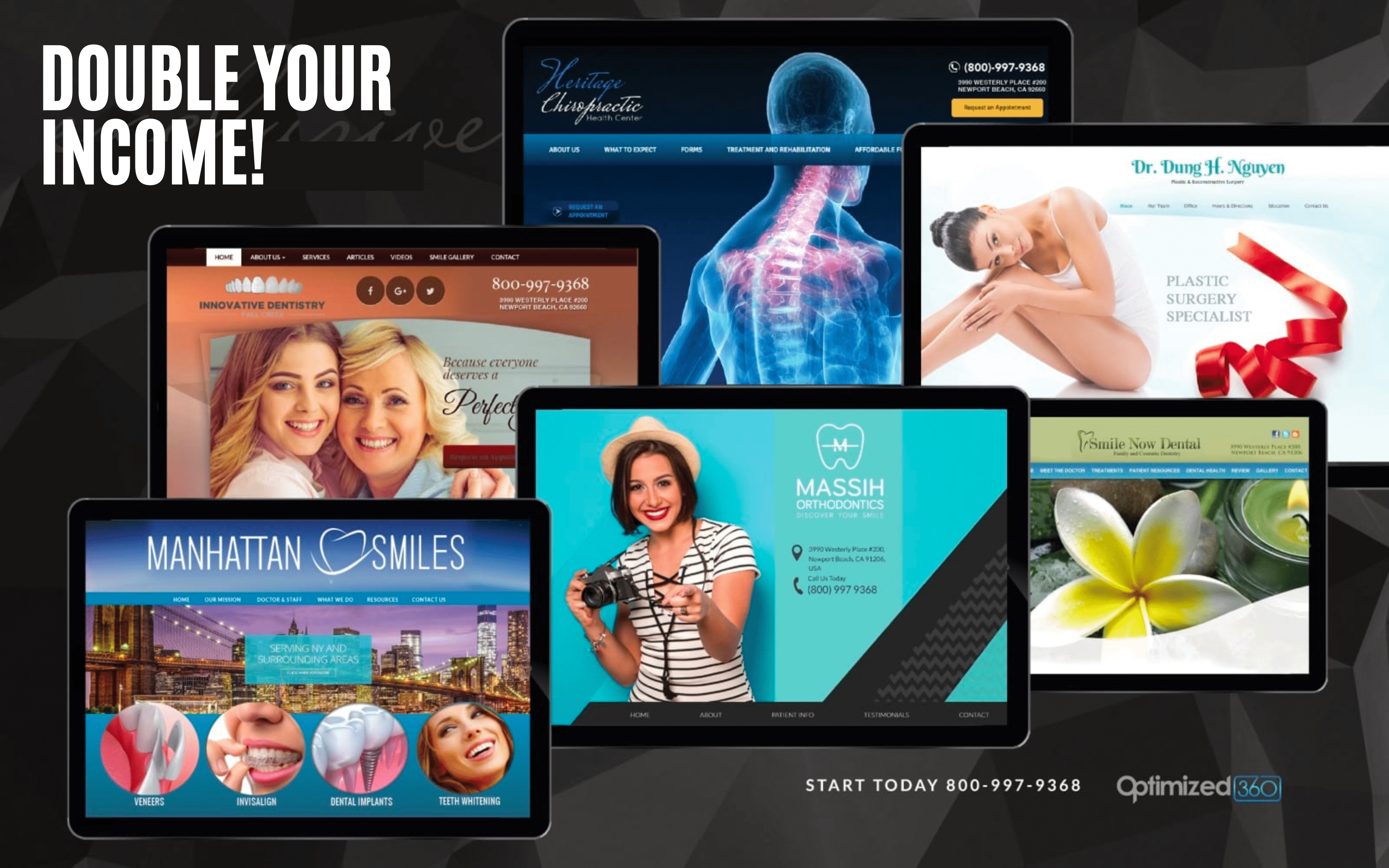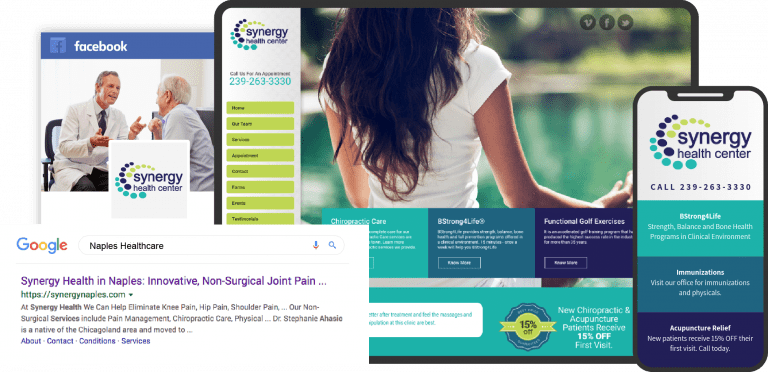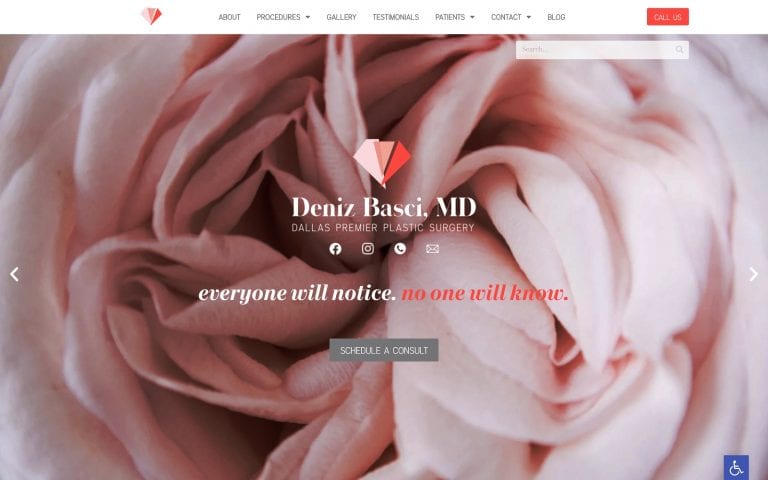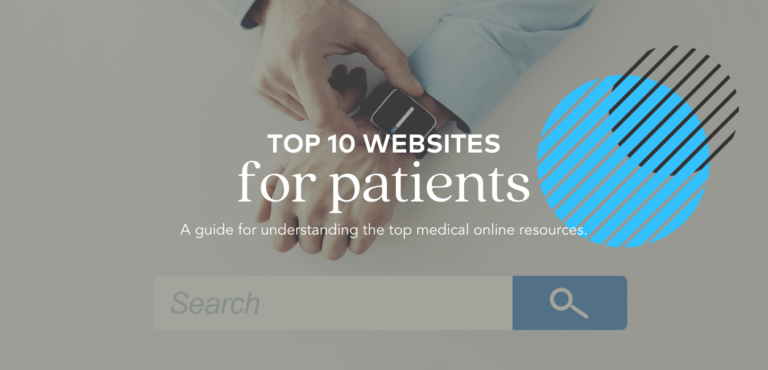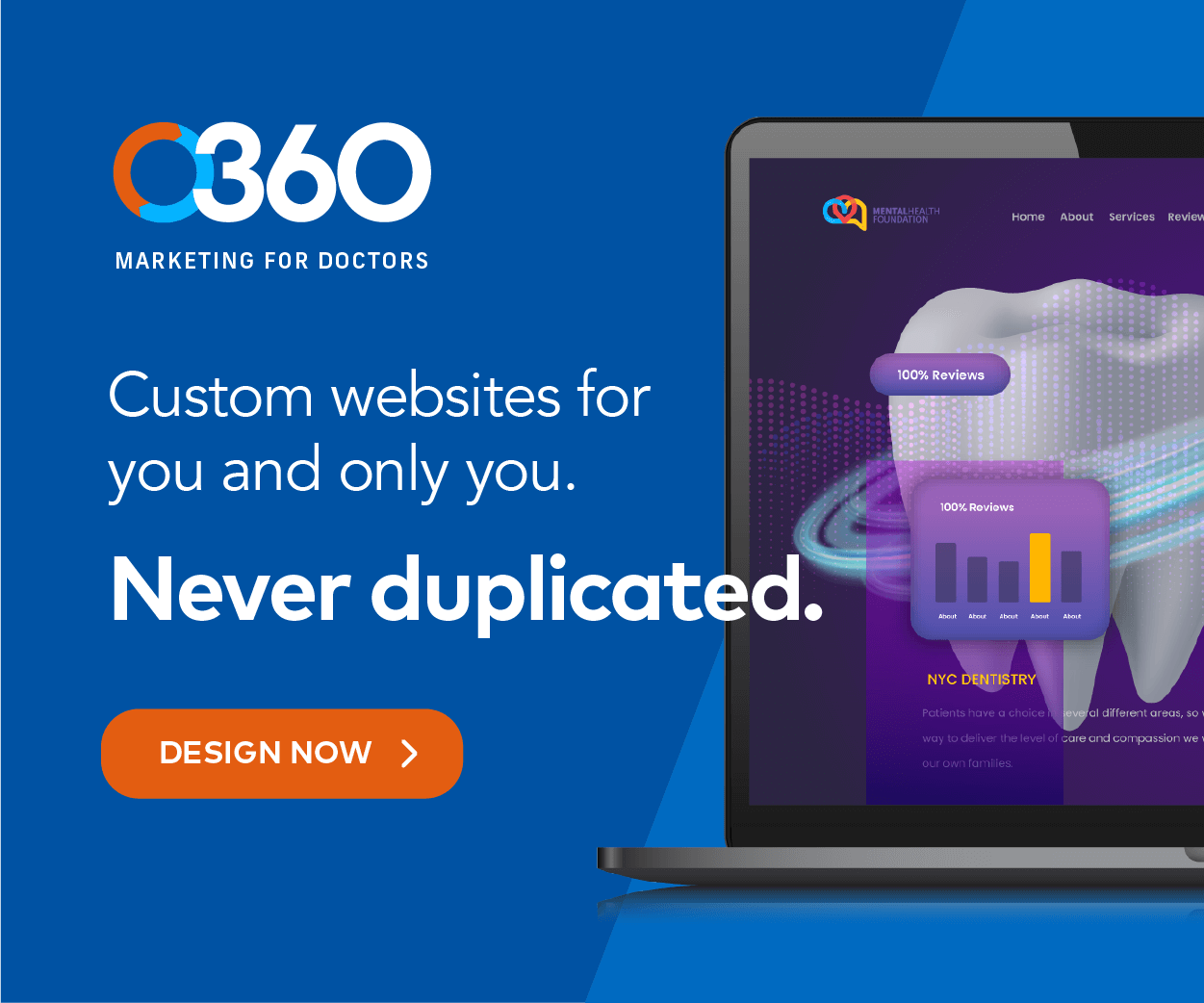Below are the latest important trends in search engine optimization that can be applied to dental websites and other healthcare websites. See examples of dental websites where these elements have been applied to.
Website Basics
1. Mobile Optimization
Optimizing your website for mobile ensures it’s fully accessible and navigable on all devices. It’s like designing your dental office to be accessible for walk-ins and wheelchairs. Mobile compatibility means a PC user and an iPhone user both see the same important information on the website. For example, ensure your appointment booking system works smoothly on smartphones. See O360 mobile websites.
2. Site Speed
Ensuring your site loads quickly is important for keeping visitors engaged. It’s similar to reducing waiting times in your waiting room. Many different methods can do this; one example would be compressing your high-quality dental images, which can significantly improve your site speed.
3. HTTPS
HTTPS is the secure version of HTTP, which provides a safer browsing environment for your users. This is akin to having CCTV cameras in your office for security. For instance, when patients fill out an online form, they want to be sure their data is secure. You would need to acquire an SSL certificate for your website to achieve that.
4. User Experience (UX)
User experience on a website is comparable to the patient’s experience in a dental clinic. It’s like having a clean, comfortable, and easy-to-navigate dental office. For example, a simple and intuitive navigation menu on your website can improve the user experience. Make things easy to find, clean to read, and intuitive to browse.
5. Core Web Vitals
Google’s Core Web Vitals measure a website’s overall user experience. It’s similar to ensuring your dental equipment is in top condition for patient comfort and safety. For example, eliminating pop-ups that shift the content around (CLS metric) can improve your site’s Core Web Vitals. You can also minify code and remove unused CSS and plugins.
Content Quality and Relevance
6. E-A-T Principles
E-A-T stands for Expertise, Authoritativeness, and Trustworthiness. It’s like displaying your dentistry degrees, certifications, and testimonials in your office. For example, featuring articles written by dental experts on your site can increase your E-A-T. It basically means you show that you are qualified to provide the information on your website. If you are talking about Oral Surgery and advising people on what type of post-surgical care they should follow, Google wants to ensure your information is legit and not harmful to your readers—using your name, for example, as the author is a positive.
7. Quality Content
Publishing high-quality content on your dental website is like providing informative brochures about dental procedures in your waiting room. For example, an in-depth article on the benefits and procedures of dental implants can engage and educate visitors. Make sure to cover three types of content. Informational oral health content, like how to brush your teeth. The common type of dental diseases and conditions like tooth abscesses or impacted wisdom teeth. And the treatments and procedures you offer to treat these diseases, like root canal treatment or dental veneers.
8. Dental Blogging
Regularly updating a blog about dental topics is similar to holding public lectures on oral health. For instance, a weekly blog post on topics like “The importance of flossing” or “How to prevent gum disease” can drive traffic and position you as a dental authority. Share these blogs on your website as well as your social media pages.
9. Long-Form Content
Publishing detailed, long-form content about dental topics is like writing a comprehensive, in-depth dental health guide for your patients. For example, an extensive guide on orthodontics can provide value to potential patients looking for braces or aligners. Such content can cover everything there is to know about the type of orthodontic treatments with images and videos and links to resources.
10. FAQs
Having a section on your website dedicated to frequently asked questions about common dental procedures is like providing detailed answers during patient consultations. For example, answering common questions about teeth whitening can help patients feel more prepared and reduce their anxiety. Make sure to cover questions like pricing and insurance coverage questions. Even if you don’t want to put exact prices, reduce your patient’s anxiety by providing some guidelines and estimates.
Online Visibility and Engagement
11. Local SEO
Local SEO helps promote your services to local patients. It’s the same as distributing flyers in your neighborhood. For example, optimizing your site for keywords like “Dentist in [your city]” can increase your visibility in local search results. Add a map to your location and links to your local listings and reviews online.
12. Voice Search
Optimizing your website for voice search is like being listed in the phone book. For instance, structuring your contact information clearly can help voice assistants provide accurate information about your practice. Using standard code and content management systems like WordPress is one way of ensuring your code is readable by voice recognition tools.
13. Online Reviews
Positive online reviews can boost your online reputation. It’s the digital equivalent of word-of-mouth recommendations. For example, encouraging satisfied patients to leave a Google review can improve your online credibility. Having reviews on multiple websites improves your situation score, which means it is more likely that Google recognizes you as a legitimate business and more trustworthy.
14. Video Marketing
Creating video content about your services is like having a commercial on local TV. For instance, a video tour of your dental clinic or a testimonial from a satisfied patient can make a strong impression. You can also use premade patient education videos made for dentists.
15. Social Media Signals
Having a strong social media presence can help you engage with your community. It’s like participating in local events to build relationships. For example, sharing oral health tips or clinic updates on your Facebook page can increase engagement and reach. Connect your social pages to your website’s blog. Use images and media too.
Technical SEO

16. Keyword Research
Identifying the right keywords can help you attract more relevant traffic. It’s like conducting market research to find out what services your potential patients are most interested in. For instance, if you offer cosmetic dentistry, you’d want to rank for keywords like “teeth whitening [your city].” But don’t overthink it. Any relevant content will do you good.
17. Image Optimization
Optimizing images on your website can improve load times and accessibility. It’s like arranging your office signage and graphics for maximum visibility. For example, adding alt text to your dental procedure images can help visually impaired users and search engine bots. Also, use images at the size needed, not bigger or smaller. At the same time, maintain the quality of the images. Low-quality, pixelated images are a turnoff for your visitors.
18. Schema Markup
Schema markup helps search engines understand your website content better. It’s like clearly labeling different sections of your office. For instance, adding schema to your office hours and location can help them appear directly in search results. Many good content management systems do this automatically.
19. Backlinks
High-quality backlinks to your website can improve your search engine ranking. It’s like having other local businesses refer their customers to your practice. For example, a link from a respected local health blog to your site can increase your domain authority. Try to connect to your referral sources like the orthodontist you may refer to or other medical doctors that are your neighbors. Backlink buildup strategies for chiropractors that can be used by everyone.
20. Optimized Metadata
Well-optimized metadata can improve your click-through rate from search results. It’s like having a clear, informative signboard outside your dental office. For example, a meta description summarizing your practice and services can entice more people to click. Any good web designer will do this for you. Check O360 dental website designers.
Google Services
21. Google My Business
Updating your Google My Business profile helps people find and contact your practice. It’s like listing your dental practice in the Yellow Pages. For example, ensuring your office hours, phone number, and address are accurate can improve your local SEO. You can find your listing on Google Maps and then claim it.
22. Featured Snippets
Creating content that could be used in Google’s featured snippets can boost your visibility. It’s like placing a billboard on the roadside that answers a common dental question. For instance, a well-structured answer to “What are the signs of gum disease?” could be featured in a snippet. Try to put a short and clear version of the answer at the top of the page and at the start of the article.
23. Google Posts
Using Google Posts can help you communicate updates or offers directly in search results. It’s like running a column about your dental practice in a local newspaper. For example, posting about a limited-time offer for teeth cleaning can attract more bookings. These posts will be placed on your Google My Business page and will show under your Google Maps listing.
24. Content Clusters
Organizing your content into clusters can help search engines better understand your site structure and content. It’s like organizing dental literature in your office. For example, having a main page about “Orthodontics” linking to related pages about braces, retainers, and aligners can form a content cluster. This shows Google that you are an authority and expert with experience.
25. Optimize for BERT
BERT (Bidirectional Encoder Representations from Transformers) is a Google algorithm update focusing on understanding the context of words in search queries. Training your office receptionist to understand and respond effectively to various inquiries is like training your office receptionist. For example, optimizing for long-tail, conversational keywords can help you align better with BERT. This basically means the text should be optimized for natural language understanding.
On-Page SEO
26. Headings Hierarchy
Just like organizing a dental report, your website should have a clear headings hierarchy. For example, your main topic (“Root Canal Treatment”) could be an H1 heading, with related subtopics (like “Preparation,” “Procedure,” and “Aftercare”) as H2 or H3 headings. This is just about being organized and orderly.
27. Internal Linking
Internal links between your pages are like the cross-references in a dental research paper, connecting related topics together. For example, a blog post about toothache could link to a service page about root canal treatment. Use descriptive anchor text. When visitors click on a link, they should see what they expected reading the anchor text.
28. Anchor Text Optimization
Anchor text should be relevant and descriptive, like labels on dental files, giving a clear idea of what they contain. For example, instead of “click here,” use “learn more about dental bridges.” If you are in doubt, go with a longer version.
29. URL Structure
Clean, easy-to-read URLs are like organized patient files – they help you and others quickly understand the page content. For example, use “/services/teeth-whitening” instead of “/page?123.” Also, try to keep the URL short but not too short. 3 to 4 words are totally acceptable.
30. SERP CTR Optimization
Improving your click-through rate from search results is like optimizing the sign outside your clinic to attract more patients. For example, a compelling meta description can entice more users to click on your page. Using numbers and other visible characters and words improves the click-through rate.
Content Marketing

31. Infographics
Creating dental-related infographics is like having eye-catching educational posters in your clinic. For example, an infographic about the effects of sugar on teeth can engage visitors and boost shares. You can use tools like canva.com to make infographics easily.
32. eBooks and Whitepapers
Offering downloadable content like eBooks or whitepapers is akin to providing detailed dental health guides. For example, an eBook about “Oral Health for Children” can provide value to parents and help gather email addresses. This can increase your visitor’s engagement and returns.
33. Podcasts
Hosting a dental podcast can help you connect with your audience personally. It’s like hosting a dental radio show, discussing topics like “Orthodontics for Adults,” or interviewing industry experts. While this is not for everyone, it is also much easier than you may think. You can simply record yourself with your phone discussing popular topics and upload it.
34. Webinars
Hosting live webinars about dental health is like conducting oral health workshops. For example, a webinar about “Teeth Whitening Options” can provide value to potential patients and position you as an expert. If you have a technical team, they can arrange everything for you, and you will join in and discuss a topic of interest.
35. Case Studies
Publishing dental case studies can demonstrate your expertise and success in real-world cases. It’s like presenting successful patient cases at a dental conference. For example, a case study about a complex orthodontic treatment can showcase your expertise and results. Use images and videos of patients when possible. For example, a before and after gallery of full-mouth veneer cases is something very popular.
Link Building
36. Guest Posting
Guest posting is like speaking at another clinic’s event. It builds relationships and exposes you to a wider audience. For instance, a guest post on a popular health blog can boost your website’s traffic and authority. Reach out to website owners with relevant topics and simply ask them for a link back. Learn about back link building.
37. Influencer Collaboration
Working with influencers in the health sector can boost your online visibility. It’s like having a well-known figure visit your clinic and share their experience. For example, a local fitness influencer could feature your teeth-whitening service. It is also something that looks harder than it is. Sometimes just a DM will be enough to set up an endorsement.
38. Resource Link Building
Creating valuable resources can earn you links from other websites. It’s like developing a new dental procedure that other dentists refer to. For example, a comprehensive guide about “Dental Care for Diabetics” could attract backlinks from diabetes websites. Studies, infographics, and other useful elements can be something others would link to.
39. Local Business Directories
Listing your clinic in local business directories is like having your clinic listed in the local phone book. For example, ensuring your clinic is listed on Yelp and Yellow Pages can improve your local SEO. You can get help from your staff and do this quickly.
40. Competitor Backlink Analysis
Competitor backlink analysis is like studying the referral sources of other successful clinics. For example, using tools like SEMrush or Ahrefs, you can discover new link-building opportunities. There are also free tools online, or you can use the Google Search Console to get info on linked websites.
SEO Analytics
41. Google Analytics
Using Google Analytics is like conducting patient surveys to understand their preferences and behavior. For example, you can track which service pages are most visited and work on improving others. The more information you have, the better you can decide what to do most. Learn about the importance of analytics in web development.
42. Google Search Console
Google Search Console helps you monitor your site’s performance in Google Search. It’s like getting a patient feedback report specifically for your clinic’s visibility. For example, it can show you which queries drive traffic to your site. The console has improved and becomes more useful over time, and I suspect that will continue.
43. Bounce Rate Analysis
Analyzing your bounce rate can provide insights into user engagement. It’s like tracking how many patients leave the waiting room before their appointment. For example, if your blog posts have a high bounce rate, consider improving their readability or adding more relevant links. You want people to stay on your website more, but not because they are confused or can’t find what they need. But because they find the information useful or like to watch a video you have added.
44. Conversion Rate Optimization
Conversion rate optimization is about turning more website visitors into patients. It’s like refining your consultation process to increase the number of patients accepting treatment. For example, you could optimize your contact form for ease of use and clarity. Making a visible CTA (call to action) available across your website is one way to do this.
45. A/B Testing
A/B testing different elements on your website is like testing different office layouts to see which patient prefers. For example, you could test two different call-to-action buttons on your booking page to see which gets more clicks. Without texting, how do you know what works best? Don’t rely on guesswork. There are tons of tools that can do this.
Online Reputation Management

46. Managing Negative Reviews
Dealing with negative online reviews is like addressing patient complaints in your clinic. For example, responding professionally and understanding a dissatisfied patient can show potential patients that you care about their experience. Learn more by reading our blog on how to respond to negative reviews.
47. Encouraging Positive Reviews
Just as you’d encourage satisfied patients to refer their friends to your clinic, you should encourage them to leave positive reviews online. For example, you might provide a small thank-you gift to patients who review your services. Sometimes simply asking your patients will be enough.
48. Monitoring Your Online Presence
Keeping track of where and how your clinic is mentioned online is like keeping an ear to the ground in your local community. For example, setting Google Alerts for your clinic’s name can help you stay on top of your online reputation. You can use tools or search for yourself.
49. Claiming Your Business Listings
Claiming your business listings on all relevant online directories is like ensuring your clinic is correctly listed in all local phone books. For instance, ensure your clinic is listed and accurate on platforms like Yelp, Google My Business, and local healthcare directories. Don’t forget about Bing and Yahoo. They have lower numbers of visitors but are less competitive.
50. Featuring Patient Testimonials
Patient testimonials can be a powerful marketing tool, similar to word-of-mouth recommendations offline. For example, featuring video testimonials on your website can help build trust with potential patients. Simply use your phone to record your patients. Don’t worry about the quality of being ‘perfect’.
Personalization and User Experience
51. Personalized Content
Creating personalized website content is like addressing each patient by their name when they visit your clinic. For example, offering personalized oral health tips based on a user’s browsing history can improve engagement. Even if you have a content copywriter, it is a good idea to review the content and spend a few minutes personalizing the article.
52. Interactive Elements
Interactive elements on your website are like interactive displays in your waiting room. For instance, an interactive tool that helps users visualize the effects of different treatments can make your site more engaging. Add a before and after gallery or a tool to see how teeth whitening can change the shade of teeth after the procedure.
53. Chatbots
Chatbots can respond immediately to user inquiries, like a receptionist answering patient queries. For example, a chatbot could answer basic questions like “What are your office hours?” or “Do you offer teeth whitening?” Today, even AI chatbot tools can be trained to handle at least simple conversations.
54. Easy-to-Find Contact Information
Making your contact information easily accessible is like prominently displaying your reception desk. For instance, including your phone number and email address in the header or footer of your site can improve the user experience. Having a separate contact us page is a good idea, but again, making it available on all pages is beneficial.
55. Clear Calls to Action
Clear calls to action (CTAs) guide users towards desired actions, like a receptionist guiding a patient to book their next appointment. For example, a CTA like “Book your dental cleaning today!” can direct users toward the online booking form. Highlight your CTAs with contrasting colors or shapes.
Multilingual SEO
56. Translation and Localization
Translating and localizing your website is like having multilingual staff at your clinic to serve a diverse patient base. For example, providing Spanish language options for your website can attract more Hispanic patients in your area. You can use a free link or new AI tools for this.
57. Hreflang Tags
Hreflang tags help search engines understand a webpage’s language and geographical targeting. It’s like using different signboards for different language speakers. For instance, using hreflang tags can ensure that Spanish-speaking users see your Spanish-language pages. Most local dental offices may not need this, but this is vital if you have international patients or offer dental tourism services.
58. Multilingual Keyword Research
Researching keywords for different languages is like understanding the specific needs of different patient demographics. For instance, you might find that Spanish-speaking users in your area are particularly interested in orthodontic services. Use ChatGPT for this. It is a very efficient tool.
59. International Link Building
Building links from foreign-language websites can boost your site’s visibility among non-English-speaking users. It’s like receiving referrals from other clinics that serve the same demographic. For example, a link from a popular Spanish-language health blog can help boost your visibility among Spanish-speaking users. Use someone on Upwork to help you build these links.
60. Cultural Sensitivity
Just as you’d be culturally sensitive in your interactions with patients from different backgrounds, your website content should be sensitive to cultural differences. For example, your Spanish-language content should consider cultural nuances in discussing oral health. If you have bilingual staff, ask them to review your site.
Mobile SEO

61. Mobile-Friendly Design
Having a mobile-friendly website is like having a wheelchair-accessible clinic. It allows more patients to interact with your practice conveniently. For instance, ensure your site’s design scales well to different screen sizes. Check examples of our mobile websites.
62. Accelerated Mobile Pages (AMP)
AMP can make your site load faster on mobile devices, similar to having a fast-track service for busy patients. For instance, consider implementing AMP for your blog posts to reduce load times for mobile users. AMP is becoming less necessary these days. Regular speed optimization can replace the need for an AMP plugin.
63. Mobile User Experience
Optimizing the mobile user experience is akin to optimizing the patient experience at your clinic. For example, ensure that interactive elements on your site are easy to use on a touchscreen. Deal with your mobile site like a separate website. It is not a small version of your website; it is like other tools to gain new patients.
64. Mobile-First Indexing
With Google’s shift to mobile-first indexing, it’s crucial to prioritize your mobile site, much like prioritizing emergency patients in a dental clinic. For instance, ensure that all content and links on your desktop site are also present on your mobile site. Ensure your content is the same for both desktop and mobile versions of your website.
65. Voice Search Optimization
Optimizing for voice search is like accommodating patients who prefer phone calls over online booking. For example, include conversational keywords in your content, as voice searches tend to be more conversational.
Structured Data and Schema Markup
66. Business Information Schema
Using schema markup for your business information is like clearly displaying your clinic’s signboard. It helps search engines understand and display important information about your practice, such as your address and office hours. There are a lot of plugins that help you with this setup.
67. FAQ Schema
Implementing FAQ schema is similar to having a well-structured FAQ brochure in your clinic. It can help your answers to common questions appear directly in search results. For example, you might have an FAQ page about dental implants with a markup for each question and answer. Use Answer the Public to find out the most common questions that need answers by patients.
68. Reviews and Ratings Schema
Using schema markup for your reviews can help them stand out in search results, similar to displaying patient testimonials in your clinic. For instance, aggregated review ratings can appear directly in search results for your clinic. Use a plugin to insert reviews.
69. Video Schema
Video schema markup can help your videos appear in Google’s video search results. It’s like advertising your clinic on a local TV channel. For example, if you have educational videos about dental procedures, video schema can help them get found. Our patient education videos already support this feature.
70. Local Business Schema
Local business schema can help search engines understand and highlight your local business information. It’s like submitting your clinic’s details to a local business directory. For instance, it can help search engines recognize and display your clinic’s location, hours, and contact information. Google map plugins may help accomplish this task.
Social Media Integration

71. Social Sharing Buttons
Including social sharing buttons on your site is like encouraging your patients to refer their friends to your clinic. For example, users can easily share your blog posts on their social media, increasing your online exposure. WordPress plugins are available for inserting these types of buttons. Just add your social page URL, and you are good to go.
72. Social Media Feeds
Displaying social media feeds on your site is akin to showing a live community bulletin in your clinic. For instance, a live Instagram feed can show users your recent posts and encourage them to follow you. Several plugins are available to display your social page content on your website.
73. Social Media Metadata
Social media metadata can control how your pages look when shared on social media. It’s like designing a brochure specifically for distribution at a community event. For instance, Open Graph tags can determine the title, description, and image shown when your page is shared on Facebook.
74. Social Proof
Displaying social proof on your site, like testimonials and reviews, is similar to showing a wall of thank-you cards from satisfied patients. For instance, Facebook reviews could be embedded on your site to show real patient feedback. The same plugins that display Google Maps can also display their reviews.
75. Social Media Listening
Social media listening is like being aware of what’s being said about your clinic in the community. It allows you to understand and engage with the conversation about your practice online. For example, monitoring mentions of your clinic on Twitter can provide valuable insights and opportunities for engagement. Use people on FIVERR to add these listings for you.
User Experience (UX) and Core Web Vitals
76. Loading Speed
Fast loading speed for your website is like reducing waiting times for your patients in the clinic. For instance, optimizing images and using a fast web host can help your site load quicker, providing a better user experience. Nitro Pack is a popular speed optimization plugin that is very useful for speed improvement.
77. Interactivity
Ensuring interactive elements on your site work smoothly is like having a responsive and attentive receptionist at your clinic. For example, ensure that form inputs and buttons work well and responses are swift. Simply ask for feedback from your website visitors to find out if this works well.
78. Visual Stability
Visual stability refers to preventing layout shifts during page load. It’s like ensuring a stable and consistent environment in your clinic. For instance, avoid pop-ups or elements that could shift content and disrupt the user’s activity. Check your site from different types of internet connections, even G3, and see if your website does OK.
79. Easy Navigation
A well-structured and intuitive navigation menu is like clear signposting within your dental clinic. For example, categorize your services under a ‘Services’ menu item and provide a clear path to booking an appointment. This is especially important for the mobile version, as complicated menus take over the whole page.
80. Accessibility
Website accessibility, like clinic accessibility, ensures that everyone, including people with disabilities, can use your site effectively. For example, providing alt text for images can help visually impaired users understand your content. Check our Accessibility Plugin, which uses AI to improve the availability of the whole page to patients with a wide range of disabilities.
Local SEO
81. Google My Business
Claiming and optimizing your Google My Business profile is like getting the prime listing in your local business directory. Ensure you have accurate and comprehensive information, including services, hours, and contact details. Keep Yahoo, Google Maps, and Apple Maps in mind.
82. Local Citations
Getting your dental practice listed in local online directories is like distributing your business card at a local business event. Ensure your Name, Address, and Phone number (NAP) are consistent across all listings. Some services, like FIVERR, are available online that post 100s of situations for a small fee.
83. Localized Content
Creating content relevant to your local community is like sponsoring a local event. For example, a blog post about a local charity event your clinic participated in can help you connect with local patients. Write about your city and local events.
84. Local Backlinks
Getting backlinks from local businesses and organizations is like getting a shoutout at a local community meeting. For example, linking to your local chamber of commerce can help boost your SEO. Talk to your neighbors, friends, and other local businesses.
85. Online Reviews
Encouraging and responding to online reviews is akin to interacting with patients in your waiting room. For instance, respond professionally to both positive and negative reviews, demonstrating your engagement and commitment to patient satisfaction.
Security and Privacy
86. HTTPS Encryption
Having HTTPS encryption is like providing a safe and private space for your patients to discuss their health concerns. For instance, ensuring your website uses HTTPS can secure information exchanged between the user’s browser and your website. All our websites include an SSL Certificate.
87. GDPR Compliance
Being GDPR compliant is like respecting your patients’ rights to their personal data. Ensure your website has a clear privacy policy, cookie consent, and mechanisms for data access, rectification, and erasure requests. If you have patients in Europe, this may be necessary. For now, not needed in the US.
88. HIPAA Compliance
If you handle protected health information of US-based patients, being HIPAA compliant is like abiding by patient confidentiality principles in your clinic. For instance, use secure methods to transmit electronic patient data. Learn more about HIPAA regulations here.
89. Data Security
Strong data security measures are like having a secure filing system and locked cabinets for patient files. For example, use strong passwords, two-factor authentication, and keep your website software up-to-date to prevent breaches.
90. Transparency
Being transparent about how you use user data is like being upfront about your clinic’s procedures and charges. For example, your privacy policy should clearly outline how you use cookies and personal data. Add the disclaimers in your legal section.
Analytics and Reporting
91. Google Analytics
Using Google Analytics for tracking website performance is like keeping patient records to understand their health history. For instance, monitor metrics like traffic sources, bounce, and conversion rates to understand and improve your website’s performance. Without information, you don’t have a way of improving your efforts.
92. Conversion Tracking
Setting up conversion tracking is like tracking patient recovery rates to understand treatment effectiveness. For example, set up goals in Google Analytics to understand which marketing strategies are driving appointments. Other available tools include Inspectlet and Crazy Egg.
93. A/B Testing
A/B testing different website elements is like trialing two different patient reminder systems to see which is more effective. For instance, you could test two different call-to-action messages to see which leads to more online bookings. Compare one thing at a time. Don’t have too many differences in pages A and B simultaneously.
94. User Behavior Analysis
Analyzing user behavior on your site is akin to observing patient behavior in the clinic to improve service quality. For instance, use tools like Hotjar or Google Analytics to understand how users interact with your site and identify areas for improvement. Inspectlet is another helpful tool. You would be watching videos of your visitors and their behavior.
95. Regular Reporting
Regularly reporting and reviewing your website’s performance are like routine patient check-ups. For example, monthly reports can help you spot trends, understand the impact of your SEO efforts, and adjust your strategy as necessary.
Advanced SEO Techniques
96. Artificial Intelligence
Leveraging AI in SEO, like using AI in dental treatments, can greatly enhance effectiveness. For instance, AI can help you understand search intent more accurately and optimize your content accordingly. ChatGPT is a great tool for improving your SEO. As a matter of fact, I got help from it to gather some of the information for this page.
97. Automated SEO
Automating some aspects of your SEO is like using an automated appointment reminder system – it saves time and improves efficiency. For instance, tools can automate tasks like meta tag creation or SEO reporting. New AI tools are getting better at this.
98. Voice Search Optimization
Optimizing for voice search is like accommodating patients who prefer to book appointments via phone. For example, include voice-friendly, long-tail keywords in your content, as people tend to use more natural language in voice searches.
99. Video Marketing
Video content, like demonstrations or patient testimonials, is like a show-and-tell in your clinic. They can be highly engaging and improve site dwell time. For instance, create educational videos about common dental procedures. Check our patient videos here.
100. Augmented Reality (AR)
AR, like 3D dental models, can greatly enhance user experience. For instance, an AR feature that allows users to ‘try on’ different tooth whitening results can make your site more interactive and engaging.
That concludes our 100 SEO trends for dental practices. SEO is a dynamic and ongoing process, so staying updated with the latest trends and continuously improving your website’s visibility and user experience is essential.
SEO is a deep field with myriad strategies to explore, so continual learning and adaptation is key to staying on top of trends and maintaining a strong online presence. If you are interested in help doing SEO and other web services, check our services:

